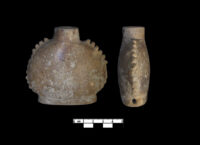Traces of Mexican marigold (Tagetes lucida) have been discovered along  with tobacco residue in Maya ceramic vessels. This is the first time a non-tobacco ingredient has been identified in a Maya tobacco container, and the first archaeological evidence that marigold was used in mind-altering plant mixtures.
with tobacco residue in Maya ceramic vessels. This is the first time a non-tobacco ingredient has been identified in a Maya tobacco container, and the first archaeological evidence that marigold was used in mind-altering plant mixtures.
Spanish chroniclers recorded the smoking of herbal blends among the Maya and Nahua, and dried marigold, on its own and mixed with tobacco, is still smoked today in Mexico. Maya smoking devices were usually organic materials like corn husks (business idea: tamale blunts) which obviously have not survived, but smoking was not the only way indigenous Mesoamericans took tobacco. It was also chewed, drunk, snuffed and administered via enema.
Nicotine residues have been found in small vessels indicating they were used to hold fresh/dried tobacco rather than the products of tobacco consumption (like spit from chaw, for example). The new study analyzed the organic remains inside 14 miniature vessels of four different forms ranging in date from 250-900 A.D. Twelve of the containers were excavated at various salvage digs over the past 15 years in Mérida, Yucatan. Two were unearthed in 2016 at the archaeological site of Ucanha.
 Samples were drawn from the vessels and compared with ones in museum collections. The archaeological residues were compared to modern extracts of eight plants — two species of tobacco (Nicotiana tabacum and N. rustica) and six other plants known from historic and ethnographic records to have been used in Mesoamerica for their psychoactive properties, including Mexican marigold. This is only the second study to deploy metabolomics, the study of small molecules known as metabolites found inside cells and tissues, to ancient residues, and it blazes an exciting new trail in archaeology.
Samples were drawn from the vessels and compared with ones in museum collections. The archaeological residues were compared to modern extracts of eight plants — two species of tobacco (Nicotiana tabacum and N. rustica) and six other plants known from historic and ethnographic records to have been used in Mesoamerica for their psychoactive properties, including Mexican marigold. This is only the second study to deploy metabolomics, the study of small molecules known as metabolites found inside cells and tissues, to ancient residues, and it blazes an exciting new trail in archaeology.
“While it has been established that tobacco was commonly used throughout the Americas before and after contact, evidence of other plants used for medicinal or religious purposes has remained largely unexplored,” [Washington State University researcher Mario] Zimmermann said. “The analysis methods developed in collaboration between the Department of Anthropology and the Institute of Biological Chemistry give us the ability to investigate drug use in the ancient world like never before.”
Zimmermann and colleagues’ work was made possible by NSF-funded research which led to a new metabolomics-based analysis method that can detect thousands of plant compounds or metabolites in residue collected from containers, pipes, bowls and other archaeological artifacts. The compounds can then be used to identify which plants were consumed.
Previously, the identification of ancient plant residues relied on the detection of a limited number of biomarkers, such as nicotine, anabasine, cotinine and caffeine.
“The issue with this is that while the presence of a biomarker like nicotine shows tobacco was smoked, it doesn’t tell you what else was consumed or stored in the artifact,” said David Gang, a professor in WSU’s Institute of Biological Chemistry and a co-author of the study. “Our approach not only tells you, yes, you found the plant you’re interested in, but it also can tell you what else was being consumed.”
The study has been published in the journal Scientific Reports and can be read in its entirety here.